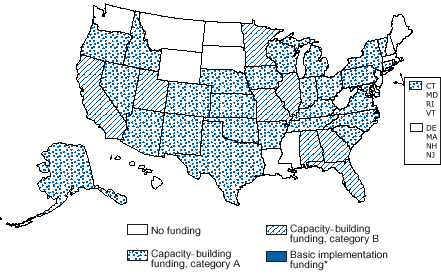
|
 |

Arthritis: The Nation’s Leading Cause of Disability
What Is Arthritis?
Arthritis comprises over 100 different diseases and conditions. The most
common are osteoarthritis, rheumatoid arthritis, fibromyalgia, and gout.
Common symptoms include pain, aching, stiffness, and swelling in or around
the joints. Some forms of arthritis, such as rheumatoid arthritis and lupus,
can affect multiple organs and cause widespread symptoms.
Why Is Arthritis a Public Health Problem?
In 2001, 49 million American adults reported doctor-diagnosed arthritis
and another 21 million reported chronic joint symptoms, making arthritis one
of the nation’s most common health problems. As the U.S. population ages,
this number is likely to increase dramatically. For example, the number of
people aged 65 or older who have arthritis or chronic joint symptoms is
projected to nearly double from 2001 (21.4 million) to 2030 (41.4 million).
Arthritis limits everyday activities for 8 million Americans. Arthritis
and the disability it causes create huge burdens for individuals, their
families, and the nation. Each year, arthritis results in 750,000
hospitalizations and 36 million outpatient visits. In 1997, medical care for
arthritis cost over $51 billion.
Arthritis is not just an old person’s disease. Nearly two-thirds of
people with arthritis are younger than 65 years. Arthritis affects children
and people of all racial and ethnic groups; however, it is more common among
women and older Americans.
What Can Be Done to Target Arthritis?
Fortunately, there are effective ways not only to prevent arthritis, but
also to reduce the symptoms, lessen the disability, and improve the quality
of life for people with arthritis.
- Weight control and injury prevention measures can lower the risk for
osteoarthritis.
- The pain and disability that accompany arthritis can be decreased
through early diagnosis and appropriate management, including
self-management activities such as weight control and physical activity.
- Self-management education programs are also effective in reducing both
pain and costs. One successful program, the Arthritis Self-Help Course,
disseminated by the Arthritis Foundation, teaches people how to manage
their arthritis and lessen its effects. This 6-week course reduces
arthritis pain by 20% and physician visits by 40%. Unfortunately, less
than 1% of Americans with doctor-diagnosed arthritis participate in such
programs, and courses are not offered in all areas of the country. More
widespread use of the Arthritis Self-Help Course and similar programs
could save money and reduce the burden of arthritis.
Most Common Causes of Disability* Among
U.S. Adults, 1999

*In this analysis, people were considered to have a
disability if they had difficulty with any one of a wide range of
activities, such as lifting or carrying 10 pounds, climbing a flight of
stairs without resting, walking three city blocks, getting in and out of
bed, bathing, dressing, preparing meals, or doing light housework. In
addition, people were considered to have a disability if they used a
wheelchair, crutches, cane, or walker for more than 6 months; were limited
in their ability to work at a job; or had any one of a number of other
limitations. For the full definition of disability, see: CDC. Prevalence of
disabilities and associated health conditions among adults—United
States,1999. MMWR 2001;50:120–5.
[A
text description of this graph is also available.]
CDC's Leadership in Arthritis Prevention and Control
What Are CDC and Its Partners Doing About Arthritis?
The National Arthritis Action Plan: A Public Health
Strategy was developed by CDC, the Arthritis Foundation, the Association
of State and Territorial Health Officials, and 90 other organizations to
address the growing problem of arthritis. This landmark plan recommends a
national coordinated effort to reduce pain and disability and improve the
quality of life for people with arthritis. This plan forms the foundation of
CDC’s work in arthritis.
With nearly $15 million in fiscal year 2004 funding, CDC is
working with the Arthritis Foundation and other partners to implement the
National Arthritis Action Plan and is supporting activities in 36
states. By carrying out the goals of the action plan, CDC and its partners
are also moving toward achieving the arthritis-related objectives in
Healthy People 2010, a comprehensive, national agenda for promoting
health and preventing disease.
What Activities Does CDC’s Arthritis Program Support?
The primary goal of CDC’s arthritis program is to increase
the quality of life for people affected by arthritis. The program achieves
this goal by supporting five key activities:
1. Building state arthritis programs.
States use CDC funding to strengthen partnerships with state
Arthritis Foundation chapters and others, increase public awareness, improve
their ability to monitor the burden of arthritis, coordinate activities, and
conduct interventions. The central aim is to let people know that something
can be done to lessen the effects of arthritis and to increase the number of
people who participate in arthritis self-help programs. CDC has the
following levels of program funding:
-
Capacity building funding (formerly known as
establishment or core funding; up to $600,000):
Category A funding (average level $140,000) allows states to begin
building an arthritis program. States funded at this level have developed
state arthritis action plans and are building programs and partnerships to
reduce the burden of arthritis. In 2003, 28 states were funded at this
level.
Category B funding (average level $300,000) carries this process
further and also allows states to conduct pilot projects to improve the
quality of life for people with arthritis. Many states funded at this
level have been able to make the Arthritis Self-Help Course and physical
activity programs available to more people, especially in underserved
areas. In 2003, eight states were funded at this level.
-
Basic implementation funding (formerly known as
comprehensive funding; $600,000–$1,000,000) would allow states to further
reduce the burden of arthritis by more broadly implementing evidence-based
interventions. States could also work with additional partners to enhance
arthritis activities. No states are funded at this level.
CDC Funding for 36 State Arthritis
Programs, Fiscal Year 2003

*Currently no states are funded at this level.
[A
text description of this map is also available.] |

|
